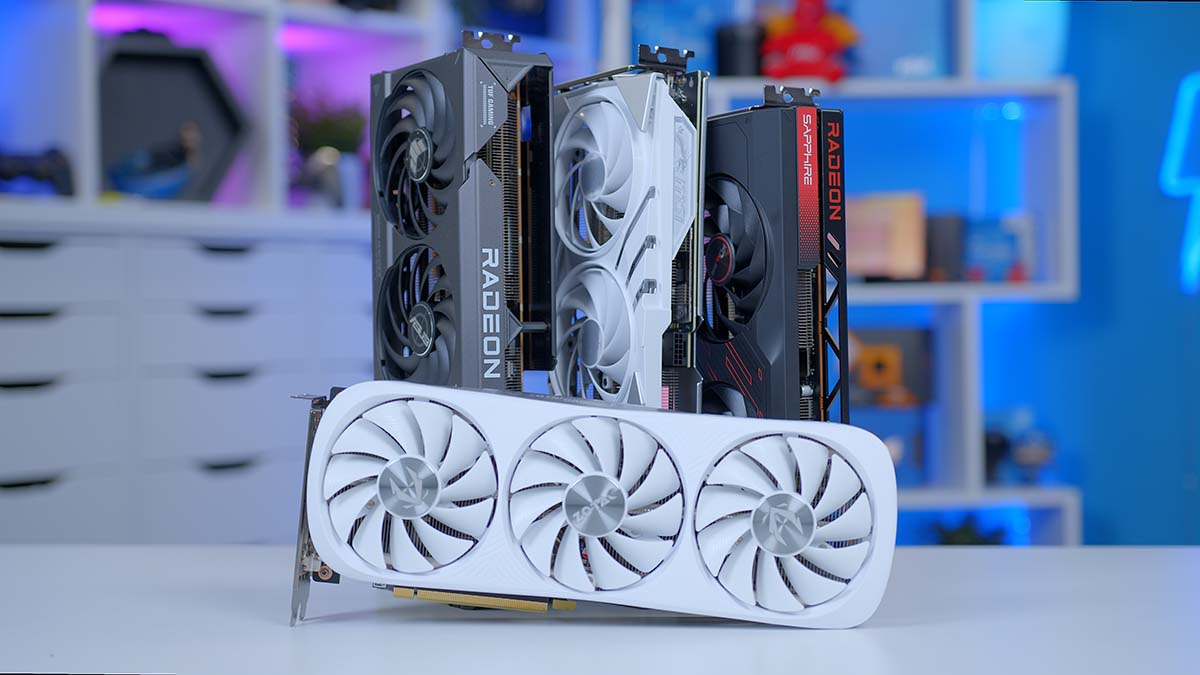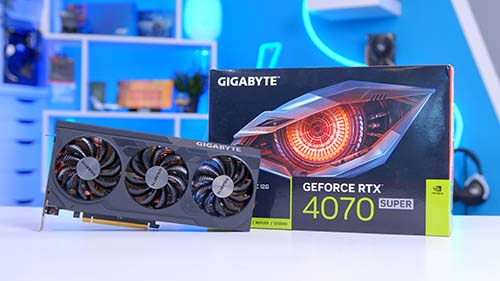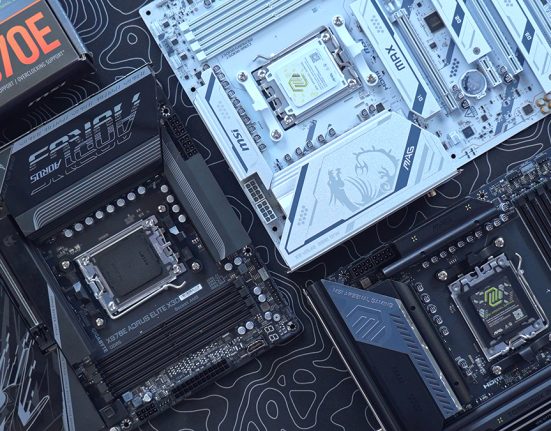The AMD Ryzen 7 9700X is a mid-range CPU from the Ryzen 9000 range, primarily targeted at 1440p and 4K gaming with the right graphics card. However, determining which GPU is the best fit is often complicated because of the wide range of graphics cards available from AMD, NVIDIA, and Intel. That’s why, in this roundup, we’ve tested an excellent selection of cards to pair up with the Ryzen 7 9700X that cater to a vast selection of budgets and use cases.
This best GPUs buyers guide examines the specs, performance, and pricing of each graphics card we’ve picked out. We’ve also included some benchmarks at the end to give you an idea of the framerates you can reach with these cards.
The Best Graphics Cards for the Ryzen 7 9700X
1. NVIDIA GeForce RTX 4070 SUPER

The first card released as part of the RTX 4000 SUPER refresh, the RTX 4070 SUPER, arrived with a hefty hardware upgrade. With increased CUDA and RT cores, the RTX 4070 SUPER is in a stronger position than the original RTX 4070, handling 1440p gaming with ease. While this card is primarily designed for 1440p, it has decent legs at 4K if you’re willing to deal with the hit to framerates.
One of the significant benefits of picking up an NVIDIA card is the exclusive software features. Pillar technologies such as DLSS 3.5 and Frame Generation bolster framerates in supported titles, allowing you to enjoy smoother gameplay with a minimal impact on resolution. Additionally, NVIDIA is one of the only manufacturers that provide GPUs that can handle ray tracing, so the RTX 4070 SUPER is a solid option if you’re looking to enjoy high visual fidelity.
| Specification | NVIDIA GeForce RTX 4070 SUPER |
|---|---|
| Video Memory | 12GB GDDR6X |
| Memory Bus | 192-bit |
| Base Clock Speed | 1.98GHz |
| Boost Clock Speed | 2.47GHz |
| CUDA Cores | 7168 |
| RT Cores | 56 |
| Tensor Cores | 224 |
| Power Draw | 220W |
| MSRP | $599 |
Regarding pricing, the RTX 4070 SUPER launched with the same MSRP as the original RTX 4070, which is $599. At the time of writing, most of the available cards still sit at this price point. Although this card isn’t as price-competitive as AMD, it’s still a reasonable ask for a 1440p/4K GPU to pair up with the Ryzen 7 9700X.
The main caveat of picking up the RTX 4070 SUPER is that the original RTX 4070 is still a tempting offer. This card wasn’t discontinued with the arrival of the RTX 4000 SUPER, and it is a cheaper option that offers relatively similar performance.



2. AMD Radeon RX 7900 GRE

The AMD RX 7900 GRE was a late addition to the Radeon 7000 lineup. Initially released as a China-exclusive for system integrators, AMD decided to capitalise on the broader market, so the GRE became available as a standalone desktop graphics card. This is one of AMD’s more popular mid-range graphics cards. Under the hood, it shares relatively similar specs to the RX 7800 XT, with 16GB of GDDR6 VRAM on a 256-bit memory bus.
However, the stream processors and ray accelerators are considerably better, which gives the RX 7900 GRE an edge in 1440p games. Much like the RTX 4070 SUPER, this card also has decent legs at 4K, so those building a top-end system with the Ryzen 7 9700X can enjoy decent framerates at higher resolutions. Framerates can also see improvements by switching on FSR and Fluid Motion Frames, which improves perceived smoothness.
| Specification | AMD Radeon RX 7900 GRE |
|---|---|
| Video Memory | 16GB GDDR6 |
| Memory Bus | 256-Bit |
| Core Clock Speed | 1.28GHz |
| Boost Clock Speed | 2.24GHz |
| Stream Processors | 5120 |
| Ray Accelerators | 80 |
| Compute Units | 80 |
| Power Consumption | 260W |
| MSRP | $549 |
Regarding pricing, the RX 7900 GRE launched at $549, but with a range of price drops since its release, it is closer to the $500 mark at the time of writing.
The RX 7900 GRE’s biggest weakness is its ray tracing performance. AMD hasn’t caught up with NVIDIA regarding ray tracing, so those looking to enjoy more visual fidelity may want to consider Team Green options.



3. NVIDIA GeForce RTX 4070 Ti SUPER

The NVIDIA RTX 4070 Ti SUPER is a card we keep returning to and often recommend for mid-range CPUs like the Ryzen 7 9700X. This second card launched within the RTX 4000 refresh and received the most substantial hardware upgrades compared to the RTX 4070 SUPER and RTX 4080 SUPER. With 16GB of GDDR6X VRAM on a 256-bit memory bus, compared to the 12GB VRAM and 192-bit memory bus on the original RTX 4070 Ti SUPER.
These specs put the RTX 4070 Ti SUPER in a considerably better position versus its non-SUPER counterpart, which was also discontinued with the arrival of the SUPER series. Performance-wise, the RTX 4070 Ti SUPER is more than capable at 1440p, but we’d argue this card is more geared towards 4K and can handle this resolution pretty easily. Especially with DLSS and Frame Gen switched on.
| Key Specs | NVIDIA GeForce RTX 4070 Ti SUPER |
|---|---|
| Video Memory | 16GB GDDR6X |
| Memory Bus | 256-bit |
| Core Clock Speed | 2.34GHz |
| Boost Clock Speed | 2.61GHz |
| CUDA Cores | 8448 |
| RT Cores | 66 |
| Tensor Cores | 264 |
| Power Consumption | 285W |
| MSRP | $799 |
The RTX 4070 Ti SUPER retains the $799 price point of the original RTX 4070 Ti, which some argue isn’t competitive. However, we believe this is an easier pill to swallow based on the sheer number of hardware improvements.
Ultimately, the RTX 4070 Ti SUPER’s price won’t be for everyone. As the Ryzen 7 9700X is more of a mid-range CPU, a card like the RTX 4070 Ti SUPER is potentially overkill. But it’s still a worthwhile pickup for 4K gaming.



4. AMD Radeon RX 7700 XT

We recommend the AMD Radeon RX 7700 XT as a budget option to pair with the Ryzen 7 9700X. This GPU has tested well in our reviews, and we were highly impressed with it during the initial launch. Subsequent price drops since its arrival have made it available for under $400 at the time of writing, which makes it one of the most competitive 1440p-capable cards on the market.
Looking at the hardware, the RX 7700 XT comes with 12GB of GDDR6 VRAM sitting on a 192-bit memory bus, which we generally recommend for budget 1440p gaming. FSR also improves framerates in select supported titles and is worth switching on if you’re OK with the slight decrease in visual fidelity.
| Key Specs | AMD Radeon RX 7700 XT |
|---|---|
| Video Memory | 12GB GDDR6 |
| Memory Bus | 192-bit |
| Base Clock Speed | 1.7GHz |
| Boost Clock Speed | 2.54GHz |
| Stream Processors | 3456 |
| Ray Accelerators | 54 |
| Compute Units | 54 |
| Power Consumption | 245W |
| MSRP | $449 |
Like the RX 7900 GRE, ray tracing is a struggle for this card, as it causes performance to suffer too much. Even FSR and Fluid Motion Frames aren’t enough to stabilise framerates.
It’s worth mentioning that spending around $50 more will net you the RX 7800 XT, a competitor to the RX 7700 XT. The RX 7800 XT has 16GB of VRAM on a 256-bit memory bus, offering more performance at 1440p.



How We Tested the Best Graphics Cards for the Ryzen 7 9700X
To provide informed product recommendations, we rigorously test all our graphics cards at varying resolutions and alternating settings within several AAA and Esports titles. Our settings are detailed in a How We Test Graphics Cards article to ensure our testing is fair and repeatable. There, you’ll find an in-depth rundown of our full testing suite for GPUs.
Starfield
Settings: 1440p, Shadow Quality High, Indirect Lighting High, Reflections High, Crowd Density High, Particle Quality High, Volumetric Lighting High, Motion Blur off, GTAO Quality High, Grass Quality High, Contact Shadows High VSync Off, DLSS/FSR OFF
All the cards in this roundup offered decent performance in Starfield at 1440p high settings. The RX 7700 XT averaged 74FPS, while the RTX 4070 SUPER offered 88FPS on average. Moving up the graph, the RX 7900 GRE and RTX 4070 Ti SUPER came out on top, with 6FPS between them, averaging 92FPS and 98FPS, respectively. Starfield is quite an intense game, so it’s great to see framerates sitting above the 60FPS mark.

Hogwarts Legacy
Settings: 1440p, Effects High, Material High, Fog High, Sky High, Foliage High, Post Process High, Shadows High, Textures High, View Distance High, Population High, Anti Aliasing TAA High, Windowed Fullscreen
In Hogwarts Legacy, at 1440p, high settings performance is slightly better than our Starfield benchmark. The RX 7700 XT, on average, provided 92FPS, which jumps up to 104FPS with the RTX 4070 SUPER. The RX 7900 GRE and RTX 4070 Ti SUPER were on top again, with 9FPS between them. It’s impressive how well the RX 7900 GRE keeps up with the RTX 4070 Ti SUPER.

3. Apex Legends
Settings: 1440p, Anti-aliasing TSAA, Texture Filtering 8X, Model Detail High, VSync Disabled, Effects High, Ambient Occlusion Quality High
In Apex Legends, performance across the board is exceptional. Apex is a much more optimised title, so framerates are generally much smoother. The RX 7700 XT offered up 175FPS on average, immediately surpassing the 144Hz sweet spot for 1440p gaming monitors. The performance from the rest of the three cards in this roundup is much closer, with the RTX 4070 SUPER and RX 7900 GRE separated by 5FPS. And the RTX 4070 Ti SUPER comes out on top yet again.

Frequently Asked Questions
How Much VRAM Do I Need for 1440p Gaming?
We recommend 12GB as a minimum, but 16GB is ideal.
Is DLSS or FSR Better?
DLSS is generally more robust than FSR without the cost of visual fidelity, but FSR is supported across all GPUs.
Can AMD Handle Ray Tracing?
Unfortunately no. AMD hasn’t quite caught up with NVIDIA when it comes to ray tracing, so the performance hit is quite significant.





![FI_[DM86] Montech King 45 Pro + RX 9070](https://geekawhat.com/wp-content/uploads/2026/01/FI_DM86-Montech-King-45-Pro-RX-9070-551x431.jpg)


![FI_[DM82] TT MineCUBE Build](https://geekawhat.com/wp-content/uploads/2025/12/FI_DM82-TT-MineCUBE-Build-551x431.jpg)
![FI_[DP056] Antec flux M + 9060XT](https://geekawhat.com/wp-content/uploads/2025/12/FI_DP056-Antec-flux-M-9060XT-551x431.jpg)